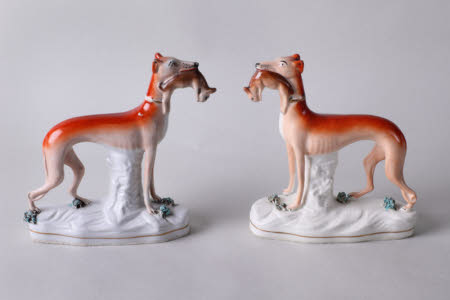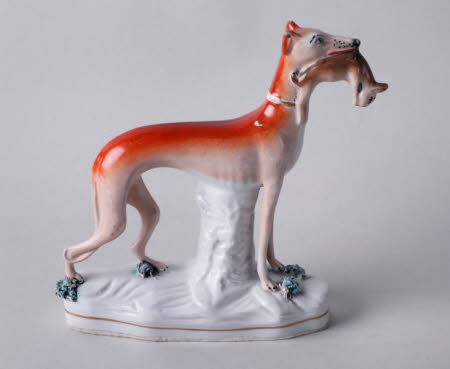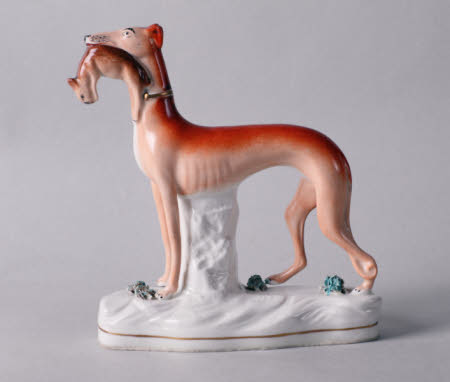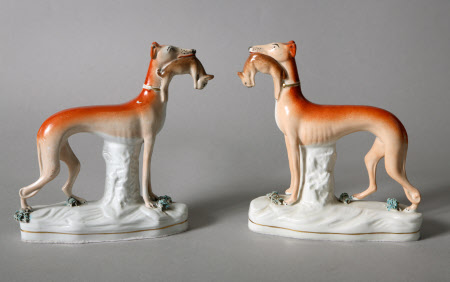Greyhound
Category
Ceramics
Date
1850 - 1860
Materials
earthenware
Measurements
195 mm (Height); 170 mm (Length)
Place of origin
Staffordshire
Order this imageCollection
Beatrix Potter Gallery, Cumbria
NT 641369
Summary
Pair of figures of greyhounds, earthenware, Staffordshire, ca 1860; decorated with underglaze colours, a band of gilding to the base, the collars and with applied foliage to the base.
Full description
This pair of figures is part of the collection at Hill Top. Beatrix Potter purchased this farmhouse and working farm in the Lake District village of Near Sawrey in 1905, using the profits from her books. After her marriage to William Heelis in 1913, Beatrix relocated permanently to Sawrey. The couple made nearby Castle Cottage their home, but Beatrix spent as much time as she could at Hill Top. As well as a space for work and creativity – and the location for many of her famous tales – it became an intensely personal sanctuary for her. Beatrix knew exactly how she would decorate Hill Top and she arranged its interiors carefully and deliberately. She wrote: ‘I would have old furniture…it is not as expensive as modern furniture, and incomparably handsomer…’ Once she had renovated the farmhouse, she filled it with examples of local furniture and treasured heirlooms, like her grandmother’s warming pan and a set of plates decorated with designs by her father. The object is described in a 1946 inventory of Hill Top, made after Beatrix’s death and after the property had been prepared for the visiting public: ‘Pair of Rockingham figures, greyhounds with hares standing on white bases encrusted with flowers’ (item 130). Each of the greyhounds holds a hare in its mouth, probably referencing the practice of hare coursing. The figures were displayed in the corner cupboard of her Sitting Room, as part of a dense, eclectic arrangement of ceramics. The Sitting Room was a fairly informal space on the upper floor of Hill Top that was used by Beatrix for entertaining friends and family. The Rockingham factory at Swinton, near Rotherham, was an important producer of fine porcelain animal figures during first half of the nineteenth century. Although they are described as ‘Rockingham’ in the Hill Top inventory, they were most probably made in Staffordshire, about 1850. Traditional Staffordshire figures seem to have held an appeal for Beatrix Potter – perhaps because they often depict rural subjects. Potter had a number on display at Hill Top and also made a few sketches of this type of figure, which are now in the collection of the Victoria and Albert Museum (LC 16/A/2, BP.372, LC 16/A/1). A figure from the same mould as the greyhound facing proper right is in the Willett Collection at the Royal Pavillion & Museums, Brighton (Beddoe, 2015, cat. 1150).
References
Pope 1999: Clive Mason Pope, A-Z of Staffordshire Dogs: A Potted History, Suffolk: Antique Collectors’ Club, 1999, figures 14, 15, pp. 48-9 Beddoe 2015: Stella Beddoe, A Potted History: Henry Willett’s Ceramic Chronicle of Britain Suffolk: Antique Collectors’ Club, 2015, fig 1150 Telford 1946: Mrs Telford, Catalogue of the Contents of Hill Top, Sawrey, typed manuscript, 1946, item 130



